Solutions to Midterm Examination
Solutions to Midterm Examination
Solutions to Midterm Examination
Create successful ePaper yourself
Turn your PDF publications into a flip-book with our unique Google optimized e-Paper software.
Prof. Li-Yan Yuan<br />
CMPUT 291: File and Database Management Systems<br />
<strong>Solutions</strong> <strong>to</strong> <strong>Midterm</strong> <strong>Examination</strong><br />
Section B1, February 24, 2004<br />
1. Construct an E-R diagram for a car-insurance company that has a set of cus<strong>to</strong>mers, each of<br />
whom owns one or more cars. Each car has associated with it zero <strong>to</strong> any number of recorded<br />
accidents. The company also maintains the statistical information for each type of vehicle,<br />
such as the accident and car theft ratio.<br />
If you have any doubt about the specification, make a reasonable assumption. Document all<br />
your assumptions. Please use the textbook notations <strong>to</strong> specify the mapping constraints. [18]<br />
2. The following ER diagram characterizes information about an on-line book s<strong>to</strong>re. Cus<strong>to</strong>mer,<br />
S<strong>to</strong>re, Book s<strong>to</strong>re information about cus<strong>to</strong>mers, s<strong>to</strong>res, and books respectively. Order represents<br />
each order placed by a cus<strong>to</strong>mer. Relationship set supply indicates which s<strong>to</strong>re supplies<br />
which book <strong>to</strong> which order; and ordered indicates who placed the order.<br />
Cus<strong>to</strong>mer<br />
S<strong>to</strong>re<br />
✻<br />
❅<br />
ordered<br />
❅<br />
❅❅<br />
❅<br />
✗<br />
Date<br />
✖<br />
✔<br />
✕<br />
❅<br />
supply<br />
❅<br />
❅❅<br />
❅<br />
✲<br />
Order<br />
Book<br />
The attributes for all entity sets are Cus<strong>to</strong>mer(c id, c name, c address), Order(o id, o data),<br />
S<strong>to</strong>re(s id, s address), Book(isbn, title, price), with c id, o id, s id, isbn as respective<br />
keys. Note that the arrow indicates the one side of the corresponding relationship set.<br />
Use the SQL’s CREATE TABLE statement <strong>to</strong> create the database schema from the ER<br />
diagram, specifying all the essential constraints. State any reasonable assumptions you may<br />
have. [12]<br />
CREATE TABLE s<strong>to</strong>re (<br />
s_id int,<br />
s_address VARCHAR(200),<br />
PRIMARY KEY (s_id)<br />
)<br />
1
CREATE TABLE book (<br />
isbn VARCHAR(24),<br />
title VARCHAR(48),<br />
price NUMERIC(10,2),<br />
PRIMARY KEY (isbn)<br />
)<br />
CREATE TABLE cus<strong>to</strong>mer (<br />
c_id int,<br />
c_name VARCHAR(128),<br />
c_address VARCHAR(200),<br />
PRIMARY KEY (c_id)<br />
)<br />
CREATE TABLE order (<br />
o_id int,<br />
o_data VARCHAR(500),<br />
c_id int,<br />
o_date DATE,<br />
PRIMARY KEY (o_id),<br />
FOREIGN KEY c_id REFERENCES cus<strong>to</strong>mer<br />
)<br />
CREATE TABLE supply (<br />
s_id int,<br />
isbn VARCHAR(24),<br />
o_id int,<br />
PRIMARY KEY ( s_id, isbn, o_id),<br />
FOREIGH KEY s_id REFERENCES s<strong>to</strong>re,<br />
FOREIGN KEY isbn REFERENCES book,<br />
FOREIGH KEY o_id REFERENCES order<br />
)<br />
3. Consider a university registration database with the following tables.<br />
student(s id, s name, status, phone, major)<br />
professor(p id, p name, dept)<br />
teach(p id, c id, term)<br />
transcript(s id, c id, term, grade)<br />
The first two tables s<strong>to</strong>re information about students and professors; the third table indicates<br />
who teaches which course at which term; and the last table s<strong>to</strong>res information about course<br />
registration.<br />
Use SQL <strong>to</strong> express the following queries. (You results may contain duplicate tuples.)<br />
2
(a) Find the names (s name) of all students who have taken a course taught by a professor<br />
in the ’CS’ department.<br />
SELECT s_name<br />
FROM student s, transcript t, teach c, professor p<br />
WHERE s.s_id = t.s_id AND t.c_id = c.c_id AND<br />
c.p_id = p.p_id AND p.dept = ’CS’ AND<br />
t.term = c.term<br />
(b) Find the names of all students who have taken more than one course taught by a professor<br />
from the ’CS’ department. You cannot not use aggregate functions with or without the<br />
group by clause for this question.<br />
SELECT s_name<br />
FROM student s, transcript t1, transcript t2, teach c1, teach c2,<br />
professor p1, professor p2<br />
WHERE s.s_id = t1.s_id AND t1.c_id = c1.c_id AND t1.term = c1.term AND<br />
c1.p_id = p1.p_id AND p1.dept = ’CS’ AND<br />
s.s_id = t2.s_id AND t2.c_id = c2.c_id AND t2.term = c2.term AND<br />
c2.p_id = p2.p_id AND p2.dept = ’CS’ AND<br />
(t1.c_id t2.c_id OR t1.term t2.term)<br />
(c) List the names of all students who have taken a course from every professor in the<br />
’MUSIC’ department.<br />
SELECT s_name<br />
FROM student s, transcript t, teach c, professor p<br />
WHERE s.s_id = t.s_id AND t.c_id = c.c_id AND t.term = c.term AND<br />
c.p_id = p.p_id AND p.dept = ’MUSIC’<br />
GROUP BY s_name<br />
HAVING COUNT( DISTINCT p_id) >= ANY ( SELECT count(*)<br />
FROPM professor<br />
WHERE dept = ’MUSIC’<br />
)<br />
SELECT s_name<br />
FROM student s<br />
WHERE NOT EXIST ( SELECT *<br />
FROM professor p<br />
WHERE p.dept = ’MUSIC’ AND<br />
NOT EXIST ( SELECT *<br />
FROM transacript t, teach c<br />
WHERE s.s_id = t.s_id AND<br />
t.c_id = c.c_id AND<br />
p.c_id = c.c_id AND<br />
3
)<br />
)<br />
t.term = c.term<br />
(d) List the names of students whose average grade is higher than that of all junior students.<br />
A junior student is a student whose status is ’junior’.<br />
SELECT s_name<br />
FROM student s, transcript t<br />
WHERE s.s_id = t.s_id<br />
GROUP BY s_name, s.s_id<br />
HAVING AVG(grade) > ALL ( SELECT AVG(grade)<br />
FROM student s2, transacript t2<br />
WHERE s2.s_id = t2.s_id AND s2.status = ’junior’<br />
GROUP BY s2.s_id<br />
)<br />
(e) List the course id and the average grade taught by each professor in the ’CS’ department<br />
in the ’winter03’ term. That is, you are asked <strong>to</strong> list p id, c id, and the average grade<br />
for each course c id taught by p id in ’winter03’ term.<br />
SELECT p.p_id, c.c_id, AVG(t.grade)<br />
FROM teach c, transcript t, professor p<br />
WHERE c.c_id = t.c_id AND c.p_id = p.p_id AND p.dept = ’CS’ AND<br />
c.term = ’winter03’<br />
GROUP BY p.p_id, c.c_id<br />
(f) List p id and p name of all professors who have never taught a course taken by a junior<br />
student.<br />
SELECT p_id, p_name<br />
FROM professor<br />
EXCEPT<br />
SELECT p.p_id, p.p_name<br />
FROM professor p, teach c, transacript t, student s<br />
WHERE p.p_id = c.p_id AND c.c_id = t.c_id AND c.term = t.term AND<br />
t.s_id = s.s_id AND s.status = ’junior’<br />
(g) Assume that a major always coincides with a department name. list, for each department,<br />
the number of professors who are working for the department, the number of<br />
students who major in the department, and the number of courses taught by professors<br />
from the department.<br />
Note that a course taught in two different terms is counted as one, not two, course taught<br />
by the department.<br />
SELECT p.dept, count(distinct p.p_id), count(distinct s.s_id),<br />
count(distinct c.c_id)<br />
4
FROM professor p, teach c, student s<br />
WHERE p.dept = s.major AND p.p_id = c.p_id<br />
GROUP BY p.dept<br />
4. Consider a relational database about a university with the following three relations<br />
teach(Prof, Course)<br />
take(Student, Course, Grade)<br />
advise (Prof, Student)<br />
The first relation indicates the courses a prof teaches; the second tells what courses each<br />
student takes and the corresponding grades; and the last indicates advisers of a student.<br />
Write a relational algebra expression <strong>to</strong> retrieve<br />
(a) all students who do not take a course from their own advisers.<br />
Π Student (take) − Π Student (teach ✶ take ✶ advise)<br />
(b) A <strong>to</strong>ugh course is a course in which no one receives a grade higher than ’6’. List the<br />
names of all students who take only <strong>to</strong>ugh courses. [14]<br />
Π Student (take) − Π Student1 (σ C1=C2∧G2>6 (take[S1, C1, G] × take[S2, C2, G2]))<br />
Or, alternatively,<br />
Π Student (take)−Π take1.Student (σ take1.Course=take2.Course∧take2.Course.grade>6 (take1×take2))<br />
Note that both take1 and take2 are take.<br />
5




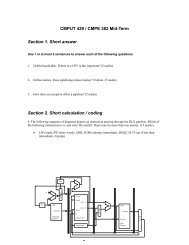

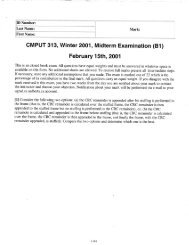
![CMPUT 313 Final Exam [Harms] April 26, 2000 g L (Ilosed Book](https://img.yumpu.com/45617471/1/190x245/cmput-313-final-exam-harms-april-26-2000-g-l-ilosed-book.jpg?quality=85)
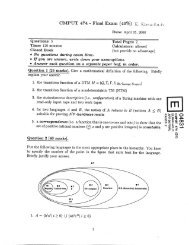
![CMPUT 379 Midterm Exam [Harms]](https://img.yumpu.com/44750568/1/190x245/cmput-379-midterm-exam-harms.jpg?quality=85)



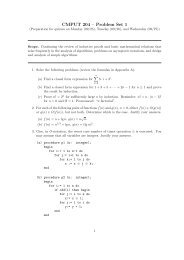

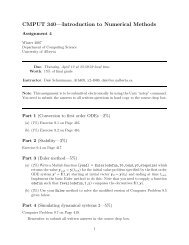
![CMPUT 272 Midterm [B2 -- Harms]](https://img.yumpu.com/36401258/1/190x245/cmput-272-midterm-b2-harms.jpg?quality=85)